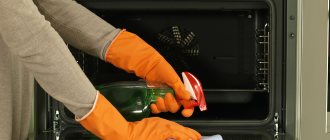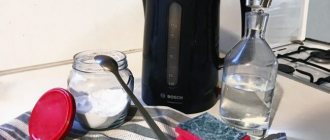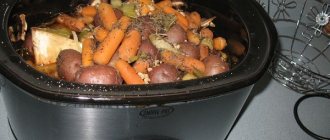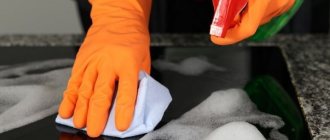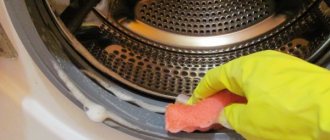Special attention is paid to the kitchen stove, because cooking, frying and almost all other thermal processing of food occurs thanks to this technique. Due to the high load, it becomes dirty very quickly: the remains of burnt food, escaped milk, dust, oil, greasy deposits - this is only a small part of everything that accumulates on the surface of the unit. Cleaning a gas stove is not so difficult; it is enough to know several methods by which getting rid of grease and carbon deposits at home will be no more difficult than brushing dust off the shelves.
Features of surface cleaning
Before proceeding directly to the procedure for cleaning the gas stove, you should find out what material was used for the coating, and choose detergents depending on it. The body and surface can be made of enameled metal or stainless steel.
Each of them has features that need to be taken into account when selecting care and cleaning agents. Removable parts should also be washed from greasy traces - handles, burners, grates, burners. Let's take a closer look at each type of coating.
Enameled
Enameled slabs are widely available and are the most popular type. Housewives choose it for such advantages as:
- wear resistance;
- durability;
- unpretentiousness;
- large selection of models in different shades;
- corrosion resistance;
- low price.
Cleaning this coating is not difficult, but there are a number of features. It is “afraid” of mechanical damage – a dent or chip cannot be removed. Enameled coating will not last as long as stainless steel.
To clean enamel, you can use any household chemicals for washing kitchen surfaces; the main rule is not to use aggressive, abrasive substances, as well as hard brushes and sponges. They can scratch the enamel, which will ruin the appearance, in addition, dirt will stick more strongly. The only powdered substance that can be used is baking soda, as it has a gentle effect on dirt without harming the coating.
Attention! Do not leave active compounds on the stove for a long time; the maximum allowed time is 30 minutes.
Many hypermarkets and specialized household chemical stores sell various enamel cleaning products, so purchasing them will be a plus.
Made of stainless steel
This species is also quite popular, for good reason. Stainless steel:
- unpretentious in care;
- wear-resistant;
- elegant;
- has a stylish design;
- looks expensive;
- has a long service life;
- not afraid of chips and dents.
However, even the slightest water stain is noticeable on stainless steel. So that it does not lose its attractiveness and shine, it is necessary to constantly wipe it. Such a surface, like an enameled one, does not tolerate hard sponges or abrasives; as damage occurs, the shine is lost.
It is better to clean a stainless steel stove with soft rags or sponges; you should choose gel or spray products. After finishing the washing procedure, carefully wipe the coating with a clean cotton cloth or paper towel so that no streaks remain. Traces of detergent and drops of water can be removed with glass washing liquid.
General rules
The choice of method for removing contaminants depends on the type of kitchen equipment for preparing hot food and the type of surface.
Cleaning the induction cooker
Electrical
Before you give your electric stove a scrub, you should unplug it from the power supply and stock up on materials and tools (rag, sponge, cleaning agent, wooden spatula). If the handles are removable, then it is better to remove them and place them in a soap solution.
It can be used for cleaning: applied to the surface, after 20 minutes especially stubborn dirt is wiped off with a wooden spatula.
Old carbon deposits are removed using abrasives and other industrially manufactured cleaners. The outside of the stove is cleaned with a soap solution. It is allowed to use an electrical appliance only after it has completely dried, and to speed up the process, it makes sense to wipe all surfaces dry with a cloth.
Gas
Operating rules require disconnecting the gas stove from the gas supply in cases where cleaning is intended. Then you should carefully remove the grate, on which a large amount of “greasy dirt” accumulates. To make it easier to remove carbon deposits, it needs to be completely immersed in a soap solution (grate 150 g of soap and dilute it in 6 liters of warm water).
If the burners and electric ignition are removable, then they need to be immersed in the same solution along with the grate for a couple of hours. Smooth surfaces can be restored to their original appearance using homemade or store-bought cleaning products.
Attention! The burners of a cleaned gas stove may not work well, so the procedure will have to be repeated using sharp objects such as a needle or awl. The gas supply holes often become clogged during the cleaning process!
Stainless steel
Grease stains can be easily removed with dishwashing detergent. To eliminate more complex stains, it is not recommended to use baking soda and other abrasive substances, as they scratch the surface.
Chlorine-containing preparations are prohibited because after their use white spots remain on the surface. The optimal solution is to use specialized tools.
Enameled
Enamel is easy to damage, so it can be cleaned with paste-like and gel-like products. The compositions are applied to contaminated areas, and after a certain time they are removed with a soft cloth or sponge. You can use an old toothbrush to clean problem areas that are difficult to reach. Some housewives use washing powder and claim that it really helps clean the enamel from grease and dirt.
Induction, with glass-ceramic coating
There are models of stoves in which induction and electric burners are hidden under a glass-ceramic coating. Glass ceramics do not accept abrasive materials, metal sponges and rags made of rough, fleecy fabrics.
To prevent the surface from losing its original gloss, it is recommended to wipe it after each use of the stove. Moreover, this is done with a soft cloth specially designated for these purposes (it cannot be used to solve other household problems).
To clean the hob, it is better to use special pastes and gels, and to restore shine, use polishes or glass and mirror cleaners. Burnt food residues should be removed immediately, preventing them from “coking”.
Preparation
Before cleaning your gas stove, prepare the surface. There are several recommendations to follow:
- First of all, you need to turn off the gas supply - close the valve on the gas pipe. This will help avoid leakage.
- Check that the surface to be cleaned has cooled down. Under no circumstances should you start cleaning if the gas stove is still hot or warm: there is a risk of getting burned and also damaging the equipment.
- Next, you should prepare the detergents that will be used. You should not mix them with each other - the result will be unpredictable.
- We must not forget about protection: aggressive household chemicals and their fumes are dangerous for the delicate skin of the hands and mucous membranes; some substances leave burns. Therefore, it is better to protect your hands with long, thick household gloves, and your respiratory tract with a medical mask.
- Afterwards, remove the dishes and all removable parts from the surface. First we remove the grates, then the burners. It is also advisable to unscrew the gas supply control knobs; it wouldn’t hurt to wash them either.
- Remove food residues that can be removed without the use of additional products.
- If you have planned general cleaning, move from top to bottom - first you should clean the surface of the stove itself, then the handles and outer walls, and lastly the oven.
When the preparation of the workplace is completed, you can safely proceed to the main stage of cleansing.
General rules for cleaning at home
Before you begin the cleaning process itself, you should understand a few simple but important rules:
- disconnect the device from the power supply and close the gas valve;
- for better access to surfaces, remove all removable elements - handles, burners, grates, stands, glass;
- Use a damp cloth to remove all small crumbly debris, leaving only stubborn stains;
- Spray water from a spray bottle onto the work surface and leave for 30 minutes - it will help soften the carbon deposits;
- Start cleaning from top to bottom - first clean the protective glass and hob, lastly the oven and sides;
- glass, enamel and ceramic elements of the stove are not resistant to mechanical damage; wash them with a soft abrasive.
Folk remedies
Everything you need to properly clean enamel or stainless steel coatings is always at hand: in the kitchen or in your home medicine cabinet. The only thing worth paying attention to is the compatibility of the active ingredient with the material.
Vinegar
Using table vinegar, you can clean the stove from strong old dirt that is difficult to remove by other means.
It is necessary to pour the acid into a spray bottle and spray it on the surface that needs to be washed off old grease and carbon deposits. If you don't have a spray bottle, carefully pour a small amount of solution directly onto the dirt. Leave for 20-25 minutes, after which the gas stove can be cleaned with a sponge.
Soda
Baking soda is a very necessary tool in the kitchen, because it is universal in both cooking and cleaning. It is suitable for cleaning both enamel and stainless steel - its particles do not scratch the surface.
If the grease stains are fresh, you can remove them like this:
- Apply a small amount of baking soda to a soft sponge.
- Rub the stained area.
- Wash off any remaining fat with warm water.
If the carbon deposits and grease are quite old and ingrained, you need to do the following:
- Pour 100 g of baking soda into a small deep bowl.
- Add a little water to it to make a thick paste.
- Spread the resulting mixture over the contaminated areas with a soft sponge and rub in lightly.
- After half an hour, rinse off the cleaning agent with a cloth soaked in clean water.
- Wipe with a dry cloth.
Vinegar + soda
This method is very effective, because acid and alkali enhance each other’s effects. After using this composition, kitchen surfaces will sparkle.
To clean a dirty gas stove at home, you must follow these steps:
- Pour a little 9% vinegar onto the stains.
- Sprinkle baking soda on top of the same areas.
- When the reaction is over, use a sponge to wash off the grease and carbon deposits.
- Rinse off the solution with clean warm water.
- Wipe the remaining liquid dry with a soft towel.
Lemon acid
This substance is known to housewives, as it works well on various types of contaminants, including adhering fat and carbon deposits.
10-15 g of lemon must be diluted in 250 ml of water, pour the resulting liquid into a spray bottle and spray on the coating. After half an hour, clean the stove with a dry cloth. If you don’t have acid on hand, you can take lemon juice or lemon (wipe half the fruit directly onto the particles of stuck food, and then rinse them with water).
Ammonia
Ammonia is actively used not only in medicine, but also in the household.
1 tsp. ammonia must be dissolved in 250 ml of water, wipe the stove, wait about 15 minutes, wash off the dirt. If the coating is enameled, it can be cleaned with a medium-hard brush, but for cleaning stainless steel, the hard side of the sponge is suitable, the main thing is not to overdo it, rub gently and carefully.
Attention! Ammonia has a very pungent odor, so before washing off the stuck-on fat, you need to ventilate the room and put on a protective mask. After the cleaning procedure, you also need to open the windows to allow air to enter the room.
Soap + soda
You can remove carbon deposits from the stove using liquid soap, baking soda and water mixed in equal quantities. The resulting mixture must be applied to the coating, cleaned off the grease, left for 10 minutes, then rinsed with clean water, and wiped dry with a soft cloth.
Soda + glue + powder
This method is suitable if the gas stove is very dirty and it is almost impossible to clean it in other ways. The ingredients in the recipe will cope with the soot, you just need to put in a little effort.
You can clean your gas stove from grease as follows:
- 1 tbsp. l. soda ash, the same amount of silicate glue, 150 g of any washing powder, 250 ml of clean water must be mixed in a small bowl so that a homogeneous mass is obtained.
- Apply the mixture on the stove for half an hour.
- After this time, clean the softened food debris with a damp sponge.
Laundry soap
This is perhaps one of the simplest methods that allows you to quickly clean the stove and dishes from old carbon and grease with a minimum of effort. Fatty acids and alkalis contained in laundry soap dissolve dirt particles, which makes it easy to remove. It also has antibacterial properties, which is a plus, especially when cleaning the kitchen.
You need to grate a quarter of a bar of soap on a fine grater, then add a little water to the shavings until a thick paste forms. Apply it to contaminated areas, after 10-15 minutes wash with the hard side of a sponge or toothbrush.
Mustard
Our grandmothers and great-grandmothers also used mustard to wash away greasy stains, because it dissolves such contaminants well.
Pour a small amount of mustard powder into a deep plate, add a little water to make a homogeneous thick paste. Then distribute the resulting mass, wait 20-30 minutes, clean the gas surface from grease with a soft sponge, and rinse with clean water.
Activated carbon
Crush 10-20 tablets of activated carbon into powder, add water to them to form a semi-liquid mass. Then you need to apply it to enamel or stainless steel, after 30-40 minutes clean it with a cloth, wash off the dirt, and remove any remaining active substance with a dry towel.
What household chemicals are suitable for cleaning the stove?
The stores offer a wide selection of cleaning products and detergents for the care of any kitchen appliances. To effectively remove fat from cooking surfaces, special fat solvents and non-abrasive products are used, which contain a surfactant that “corrodes” not only dirt, but also fat deposits. They are available in the form of creamy pastes, gels and sprays. The products of such lines as Sif, Silit, Sanitol and Sanita are in greatest demand.
Sanita
Important! Household chemicals are not always safe; they have a risk of developing allergies and require strict storage and use rules. You only need to work with it wearing rubber gloves so as not to damage the skin, and in full accordance with the instructions.
To summarize, it should be noted that the problem of how to clean the stove from grease worries most owners of kitchen appliances. Knowing the features of your stove and following simple rules for cleaning it, you can achieve perfect cleanliness in the kitchen using both special detergents and folk recipes.
How to clean handles and burners?
Handles and burners do not get dirty as quickly as the area under the grates, but they also get greasy splashes. These elements are often not given due attention; contaminants accumulate and become increasingly difficult to wash.
All removable elements should be cleaned separately, but the methods are practically the same. Washing them is usually a little easier, unless, of course, the stains are long-term. Vinegar, soda, and ammonia can easily remove grease and carbon deposits on your handles.
Soap solution
This method is suitable for small, fresh, oily marks. You need to rub a quarter of a piece of laundry soap in 1 liter of water, put the stove parts in the liquid for half an hour, then rinse them in clean water and wipe with a dry cloth.
If the burners are not very dirty, you need to wipe them with a dry cloth and check if the holes are clogged. If necessary, clean them with a pin.
How to properly clean cast iron, plastic, steel elements
The design of the stoves includes handles, gas burners, grates, burners, and oven.
Cast iron grates
They have a tendency to show signs of corrosion. If wet cleaning has been carried out, the elements must be wiped dry with a cloth. Cast iron must not be cleaned with metal sponges or brushes.
The first method is calcination. The grate is heated to extremely high temperatures in the oven, over an open fire, or using a soldering iron. Combustion products remaining after annealing can be easily removed with water, a sponge and dishwashing detergent.
The second method is boiling in a solution. For 5 liters of water: 2 tbsp. l. soda ash, 100 g of laundry soap, one grated apple. Boiling time is an individual parameter.
Oven
An effective and simple method is cleaning with hot soapy steam:
- treat the walls with soapy water;
- pour it into a baking tray;
- turn on the oven, having previously placed a baking sheet in it;
- close the door;
- set the average temperature;
- After half an hour, turn off the device and after it has cooled down, wash the walls.
Gas-burners
They do not require special care and can simply be wiped with a damp cloth. In difficult cases, the use of cleaning agents is allowed. The main thing is to take care of the cleanliness of the injectors.
Steel gratings
They are washed in soapy water, soda solution, and treated with ammonia. The last method is the most effective. To remove carbon deposits, you need to generously moisten the sponge with ammonia and thoroughly wipe the grate. Then it must be packed in a plastic bag for at least 5 hours. The final stage is washing the grate with soapy water.
Pens
If they are non-removable, then to clean them from dirt, use an old toothbrush and any cleaning agent, for example, ammonia, soda or a product purchased in a store. Dirt in hard-to-reach places can be cleaned with a toothpick. Removable handles are pre-soaked in soapy water, cleaned and washed.
Burners
Apply ammonia-anise drops to a sponge and wipe the burners. It is allowed to use a water-alcohol solution (1:1) or lemon juice.
Special means
In addition to folk remedies, you can also use household chemicals. It removes dirt faster and more effectively, but is not suitable for allergy sufferers. In addition, professional substances are often very aggressive towards human skin, so it is worth observing safety precautions.
Special products will help you clean gas and electric stoves:
- CIF Power&shine. Great for cleaning any stove top, including glass-ceramic.
- Mr. Muscle "Citrus Energy". This product can be used to clean kitchen surfaces and plumbing fixtures.
- Cillit Bang allows you to wash off many types of stains, including greasy ones.
- Electrolux e6scc106 will help remove grease and carbon deposits from stainless steel.
- Comet. The gel-like product removes dirt from any kitchen surface.
Useful tips
- Enameled and steel grates can be washed in the dishwasher.
- Glass ceramics cannot be wiped with soap and other solutions, because they become discolored when heated.
- Sugar stains on the cooking surface are easier to remove after heating.
- Stainless steel is resistant to bleaches, acids and abrasives.
- All work is performed with rubber gloves.
- You can clean the oven walls with a paste consisting of baking soda, iodized salt and water. The surfaces are generously coated with the mixture, then the oven is heated for half an hour and turned off. To remove the paste you need water and a cloth.
- The oven glass is cleaned with soda.
Tips for care and use
In order for a gas stove to serve for many months and delight you with its cleanliness, you should follow the rules for caring for equipment:
- Clean regularly. Fresh grease stains will be much easier to clean off than old carbon deposits.
- Do not neglect the use of lids - this way much less splashes of oil and food particles will get on the coating.
- When cooking, do not move far from the stove, make sure that the food does not “run away”.
- The gas stove can be covered with foil and changed when it gets dirty. This way the coating will always remain clean.
How to keep clean?
The following will help protect the stove from stubborn dirt:
- regular cleaning - wipe the cooled hob surface after each cooking, before grease and splashes have time to “tightly” dry to the coating;
- special lids, meshes and screens for dishes that protect against splashing of fat;
- foil (only for a gas stove) - cover the entire cooking surface with it, leaving holes for the burners; when dirty, replace the foil with a new one;
- anti-grease spray - sprayed onto the surface of the stove before cooking; as a result, after cooking, it will be much easier to clean off dirt.
Any stove, even if it’s not new, requires careful handling and regular maintenance. Do not allow stubborn dirt to appear, try to wash off the fat as quickly as possible after cooking - and then cleaning will not be a hassle and will not require much effort for perfect cleanliness.
How to clean the handles of a gas stove
There are different options for cleaning removable and non-removable handles. For removable ones the process is simpler. They are soaked in vinegar or soap solution for 1–2 hours.
Difficult to remove stains are removed using a sponge soaked in ammonia diluted with water. A more radical option is to immerse the handles in a solution with ammonia, placing it on the switched-on burner for 7-10 minutes. After the liquid has cooled, rinse the handles with running water.
For non-removable ones, you will need ammonia or vinegar solution sprayed onto the surface of the handles. After 5–10 minutes, wipe the surfaces with a clean, dry cloth. To clean the grooves and crevices on the handles, you can use a toothbrush, cotton swabs and toothpicks.
Oven cleaning methods
To clean the oven correctly and completely remove all dirt the first time, you should use special means at hand that you need to prepare yourself in advance. For fans of traditional cleaning methods, there are recipes that have proven themselves over the years of use, which will also be useful for those who want to learn how to clean the burners on a gas stove.
- The internal surfaces must be scrubbed with a soapy solution applied to a sponge, which is best left for 15-20 minutes - this manipulation will help dissolve old grease.
- To clean the baking sheet and internal parts, you can pour the same solution into it and put it back in the oven, turn it on, set the temperature to 120 degrees and leave for half an hour. After time, all internal parts must be wiped with a soft cloth.
- Another good way is to clean with baking soda or citric acid. One of the products should be dissolved in warm water and applied to the oven walls, then wait 15-25 minutes and wipe with paper or newspaper, rinse with water.
- Light stains inside are quickly removed with an aqueous solution of vinegar, which is prepared in a 1:1 ratio. To clean, you need to set the oven to 50 degrees and wait 15 minutes, then softened dirt can be easily removed with a sponge.
How to remove with special preparations?
There are compositions on sale that are designed to remove carbon deposits from various products. You can purchase care products for:
- behind the slabs,
- dishes,
- grill and more.
The main thing is to use them for their intended purpose. Top 3 compositions for combating carbon deposits:
Forte Plus Sano
Active foam is easy to apply using a sprayer . The composition acts quickly and effectively, thanks to the high concentration of cleaning substances. The product is suitable for caring for:
- microwave oven,
- kitchen stoves,
- grills,
- ovens.
Price – 600 rubles. Read reviews here and here.
Stop-burn + Anti-nagar
The composition for cleaning stoves and grills can be used to remove smoke from metal and enamel surfaces. It effectively copes even with old stains . Price – 200 rubles.
Kenolux Grill CID Lines
Concentrated liquid to combat carbon deposits and old fat. The composition is suitable for processing stoves, ovens and grills. Price – 800 rubles.
You need to choose a product that is marked “from carbon deposits” . Universal broad-spectrum formulations may be ineffective.
No abrasives
The enameled surface of the plate is considered quite durable. However, there are means that such coverage is justifiably afraid of. We are talking about abrasive cleaning products. Using such a detergent, you are guaranteed to say goodbye to the smooth and beautiful surface of your stove.
Important! When purchasing a product, pay attention to the packaging; it should indicate the presence of abrasive. If you come across such a word, then feel free to put it on the shelf and look for another one.
Be patient
It is only in advertising on TV that you can see how an old stain disappears in a matter of seconds. Let's be honest - this doesn't happen in everyday life. If you want all stains on the surface of the slab to be removed, and the coating itself to have its original appearance, there is clearly no need to rush.
Almost all cleaning products have an approximate waiting time written on them, but you can safely add another 5 minutes to this period. The fact is that the dirt that was on the stove must be given time to absorb the detergent while the active substances penetrate the dried stains and destroy their. Now, after this time, you can safely repeat the procedure from the advertisement and easily get rid of dirt.


